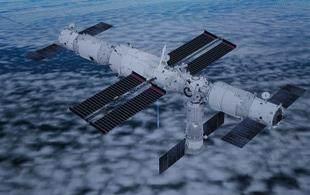The Space Span
2022-05-01ByYuanYuan
By Yuan Yuan
The three taikonauts onboard the Shenzhou-13 manned spaceship safely returned to Earth on April 16, marking the conclusion of the trio’s six-month space stint. Their epic orbital mission was a complete success.
The return capsule touched down at the Dongfeng Landing Site in Inner Mongolia Autonomous Region in north China at 9:56 a.m. that day. The return process was much shorter than before given this was the first time a Chinese manned spacecraft used the “rapid return mode.”
The new mode cut the return flight of Shenzhou-13 to just about nine hours, much shorter than the 28 hours it took for Shenzhou-12 to return in September 2021.
The three taikonauts, Zhai Zhigang, Wang Yaping and Ye Guangfu, were the second group of “residents” in China’s permanent space station Tiangong, or Heavenly Palace. Their undertaking marked many a breakthrough in China’s space program. The crew set a national record with 183 days in space. They carried out two spacewalks that totaled more than 12 hours, with Wang becoming the first female Chinese astronaut to conduct a spacewalk.

The trio also executed the docking of a cargo spacecraft with the space station’s core module by remotely controlling the mechanical arm. They further performed a number of scientific and technological experiments, and delivered two live-streamed classes from their station. They were also the first taikonauts to spend the Spring Festival, or Chinese New Year, in outer space.
Shenzhou-13 was launched from the Jiuquan Satellite Launch Center in northwest China on October 16 last year, and later docked with the space station core module, Tianhe.
Since 2020, China has successfully carried out six space missions to build the station, including the launch of the Tianhe core module, the Shenzhou-12 and Shenzhou-13 manned spacecraft, and the Tianzhou-2 and Tianzhou-3 cargo spacecraft. The core module was propelled into space in April 2021.
So far, key technologies related to physical and chemical recycling and life support, large complex control, as well as large flexible solar cell wings and driving, have all been tested.
Four extravehicular activities (EVAs) conducted by the Shenzhou-12 and Shenzhou-13 crews covered the installation and maintenance of electronics, machines, pipelines and other typical equipment outside the cabin. Their work laid the solid foundation for astronauts to install and manage EVA facilities during long-term operational periods following the future completion of the space station.
Zhong Hongen, deputy chief designer of the China Manned Space Program’s space utilization system, said during a press conference on April 17 that the containerfree and high-quality microgravity experiment cabinets inside the Tianhe core module have achieved world-leading conditions to undertake frontier-breaking research.
In late January, the State Council Information Office of China released a white paper titled China’s Space Program: A 2021 Perspective, outlining previous successes and affirming many of the country’s space exploration goals for the coming years.
According to the white paper, over the next five years, China will continue to improve the capacity and performance of its space transport system, and accelerate the upgrading of its launch vehicles. In response to the growing need for regular launches, China will develop new rocket engines, combined cycle propulsion, and upperstage technologies to render space entry and exit more efficient.
Based on this schedule, China will complete the in-orbit construction of its space station this year. Six missions are in the cards for 2022, including the launch of two lab modules—Mengtian and Wentian, two cargo craft—Tianzhou-4 and Tianzhou-5, and two crewed missions—Shenzhou-14 and Shenzhou-15.
Huang Weifen, chief designer of the China Manned Space Program’s astronaut system, revealed at the press conference that two crews of six members in total will each stay in orbit for six months. The taikonauts have already been selected and are now in the midst of their relevant training and mission preparation.
Yang Hong, chief designer of the space station system of the China Manned Space Program at the China Academy of Space Technology, gave more details of the two lab modules at the press conference. Both Wentian and Mengtian are equipped with experiment cabinets as well as an installation platform for extravehicular payloads. Inside the two lab modules, astronauts will be able to study space science, materials, medicine and exploration.
The Wentian lab module, set to blast off in May, is equipped with the same astronaut living facilities as Tianhe, including three sleeping areas, a toilet and a kitchen. Wentian and Tianhe can support six astronauts living in space.
They will become the central working area for astronauts in orbit following the completion of China’s space station construction.
The crew of the Shenzhou-14 mission will enter the Wentian and Mengtian lab modules. Taikonauts will then cooperate with ground control to complete the assembly and construction of the space station, and gradually develop it from a single-module space station into a three-module combination.
The Shenzhou-15 crew will perform several EVAs; assemble, test and debug the payloads inside modules; and control the mechanical arms to install extravehicular payloads.
Both crews will conduct scientific research experiments, collect flight mission data and carry out in-orbit training and drills.
Hao Chun, director of the China Manned Space Agency, revealed at the press conference that Tiangong, after finishing construction this year, will enter a new phase of application and development that will span more than 10 years.
The next phase in China’s march into the universe will see the annual launch of two manned spaceships and two cargo spacecraft. Astronauts will remain in orbit for a longer period of time, conduct scientific and technological experiments, and carry out space station maintenance.
China is wide open to global cooperation in the realm of universe exploration and has cooperated with many countries during its previous missions. In the country’s first Mars exploration project, for example, China cooperated with Austria and France on payloads, and with the European Space Agency on engineering technology.

Foreign Ministry spokesperson Wang Wenbin said at a daily news briefing on April 18 that China is ready and willing to team up with all countries and regions committed to the peaceful use of outer space to achieve more international cooperation and exchanges.
Wang added foreign astronauts are welcome to visit China’s space station and work with the taikonauts to jointly explore the mysteries of the universe and build a community with a shared future for humanity.
In the future, Tiangong will perform scientific experiments and technology verification related to the life sciences, material science, microgravity fluid physics, aerospace technology and aerospace medicine.
“We will manage cutting-edge scientific research on the formation and evolution of the cosmic structure, dark matter and dark energy, exoplanets and solar bodies, and expect to achieve major innovations,” Hao said.
Some space technology has already been applied to improve people’s lives. According to Hao, since China launched its crewed space program 30 years ago, over 4,000 of its technological achievements have been widely applied in various industries of the national economy. BR
